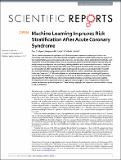| dc.contributor.author | Scirica, Benjamin M. | |
| dc.contributor.author | Myers, Paul Daniel | |
| dc.contributor.author | Stultz, Collin M | |
| dc.date.accessioned | 2017-12-12T15:27:54Z | |
| dc.date.available | 2017-12-12T15:27:54Z | |
| dc.date.issued | 2017-10 | |
| dc.date.submitted | 2017-06 | |
| dc.identifier.issn | 2045-2322 | |
| dc.identifier.uri | http://hdl.handle.net/1721.1/112707 | |
| dc.description.abstract | The accurate assessment of a patient's risk of adverse events remains a mainstay of clinical care. Commonly used risk metrics have been based on logistic regression models that incorporate aspects of the medical history, presenting signs and symptoms, and lab values. More sophisticated methods, such as Artificial Neural Networks (ANN), form an attractive platform to build risk metrics because they can easily incorporate disparate pieces of data, yielding classifiers with improved performance. Using two cohorts consisting of patients admitted with a non-ST-segment elevation acute coronary syndrome, we constructed an ANN that identifies patients at high risk of cardiovascular death (CVD). The ANN was trained and tested using patient subsets derived from a cohort containing 4395 patients (Area Under the Curve (AUC) 0.743) and validated on an independent holdout set containing 861 patients (AUC 0.767). The ANN 1-year Hazard Ratio for CVD was 3.72 (95% confidence interval 1.04-14.3) after adjusting for the TIMI Risk Score, left ventricular ejection fraction, and B-type natriuretic peptide. A unique feature of our approach is that it captures small changes in the ST segment over time that cannot be detected by visual inspection. These findings highlight the important role that ANNs can play in risk stratification. | en_US |
| dc.publisher | Nature Publishing Group | en_US |
| dc.relation.isversionof | http://dx.doi.org/10.1038/s41598-017-12951-x | en_US |
| dc.rights | Creative Commons Attribution 4.0 International | en_US |
| dc.rights.uri | https://creativecommons.org/licenses/by/4.0/ | en_US |
| dc.source | Nature | en_US |
| dc.title | Machine Learning Improves Risk Stratification After Acute Coronary Syndrome | en_US |
| dc.type | Article | en_US |
| dc.identifier.citation | Myers, Paul D. et al. “Machine Learning Improves Risk Stratification After Acute Coronary Syndrome.” Scientific Reports 7, 1 (October 2017): 12692 © 2017 The Author(s) | en_US |
| dc.contributor.department | Institute for Medical Engineering and Science | en_US |
| dc.contributor.department | Massachusetts Institute of Technology. Department of Electrical Engineering and Computer Science | en_US |
| dc.contributor.mitauthor | Myers, Paul Daniel | |
| dc.contributor.mitauthor | Stultz, Collin M | |
| dc.relation.journal | Scientific Reports | en_US |
| dc.eprint.version | Final published version | en_US |
| dc.type.uri | http://purl.org/eprint/type/JournalArticle | en_US |
| eprint.status | http://purl.org/eprint/status/PeerReviewed | en_US |
| dc.date.updated | 2017-12-11T15:39:57Z | |
| dspace.orderedauthors | Myers, Paul D.; Scirica, Benjamin M.; Stultz, Collin M. | en_US |
| dspace.embargo.terms | N | en_US |
| dc.identifier.orcid | https://orcid.org/0000-0002-9656-9474 | |
| dc.identifier.orcid | https://orcid.org/0000-0002-3415-242X | |
| mit.license | PUBLISHER_CC | en_US |
